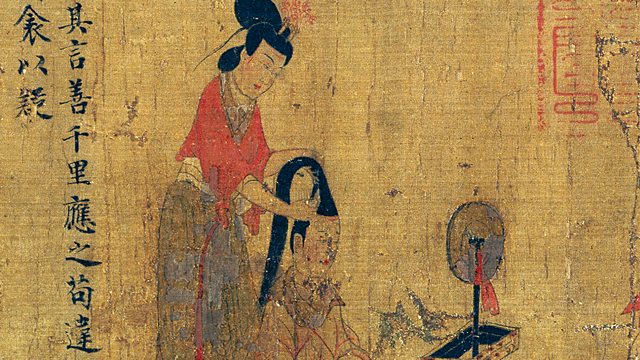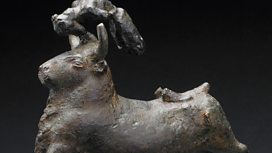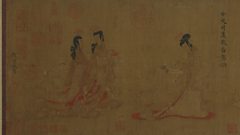Admonitions Scroll
The history of the world as told through objects arrives in China 1500 years ago. Neil MacGregor and an ancient scroll painting and poem that rules on female behaviour.
Throughout this week, Neil MacGregor has been exploring pleasure and recreation across the world of 200 years ago. Today he arrives in China to explore a painting based on a poem that attempts to define the proper behaviour for women during the tumultuous time that followed the collapse of the Han Empire. This eleven foot long scroll offers a guide to manners along well established Confucian principles. Neil MacGregor tells the story of the scroll and finds out what it is was about women's behaviour that was so worrying men of the period. The historian Shane McCausland, the politician Charles Powell, and the Chinese art expert Jan Stuart help paint the picture.
Producer: Anthony Denselow
Last on
![]()
More programmes from A History of the World in 100 Objects about sport and entertainment
About this object
Location: China
Culture: Ancient and Imperial China
Period: 6th-8th century AD
Material: Paint and Paper
��
The Admonitions Scroll is one of the most important paintings in the world. It was originally painted by Gu Kaizhi (about AD 345?406), considered to be the father of classical Chinese figure painting. The original painting is now lost, but is known through this close copy made over 200 years later. Throughout history, Chinese artists have sought to emulate Gu Kaizhi's 'gossamer brush line'. This scroll bears the red seals of Chinese emperors and private collectors who once owned the painting.
What is happening in the scroll?
The scroll's full title, Admonitions of the Instructress to the Court Ladies, indicates the work's moralising tone. The scroll's protagonist is the court instructress who advises the ladies of the palace on correct behaviour. The poem was originally written around AD 290 to reprimand Empress Jia. She used her influence to manipulate the emperor and murder rivals, during an unstable time in Chinese history known as the Period of Disunion. She ignored the poem's advice, however, and was ultimately forced to commit suicide in a coup in AD 300.
Did you know?
- Gu Kaizhi was said to have been perfect in 'painting, literary composition and foolishness'.
A seductive and unruly artwork
By Dr Shane McCausland, lecturer in History of Chinese Art, School of Oriental and African Studies, University of London
��
So what is this idea of admonitions? I think it’s about positive criticism, he’s trying to tell people what not to do, but how to do something better. Each of the scenes describes ways in which ladies of the court could improve their conduct, their behaviour, their character.
Admonition is really about learning, improving yourself, but in order to do that, if your audience is very jaded, I think you need to inject quite a lot of wit and humour into it and I think that’s exactly what this artist has done.
I don’t think it is that subversive, in that it’s presenting normative Confucian values about kingship. It happens to do this with grace and humour and wit, and it kind of seemingly undermines the message with little jokes, visual jokes going on, but I don’t think it’s seriously subversive. It does highlight a big risk though which is the duty of the statesman to represent to the rule about what he thinks is right and that saying what you think carries a great big risk. This scroll tells you that you should do that.
The scrolls link to this maverick, this genius: the founding father of Chinese figure painting, so it’s a unique survivor artwork from antiquity. To me it’s an incredibly seductive and unruly artwork, it’s both delightful and frustrating at the same time.
Celebrated importance
By Jan Stuart, Keeper of the Department of Asia, British Museum
��
Opinion continues to differ as to the exact date, authorship, and the tone of its moral message; however, Admonitions of the Instructress to the Court Ladies, attributed to Gu Kaizhi (about 345 – 406), is universally upheld as one of the most important relics of early Chinese art.
It is a work of consummate beauty executed with lithe, gossamer-like brushstrokes that presents a panoply of figures in an elegant manner that makes them seem ethereal and floating, while also confidently possessed of a convincing corporeality that makes them belong to the world of the here and now. This masterpiece embodies an early flowering of the power of narrative painting in China and demonstrates its long history in the service of moral reflection, aspirations for virtue, and as an instrument for imperial governance.
The scroll itself is also an object capable of imparting a fascinating story of transmission through the hands of major private and imperial collectors. Each marked the work with seals and inscriptions, culminating in its possession by the Qianlong Emperor (reigned 1736 – 1796), who designated it as one of his “Four Beauties,” a title for his most precious paintings. This name also reflects the four qualities of his rulership — kindness, righteousness, loyalty, and trustworthiness, enfolding the Admonitions scroll one more time in its long history into the service of changing political rhetoric.
As a rare survivor from antiquity — some might say even the earliest extant narrative hand scroll painting — it tells us much about China’s artistic brilliance some 1000 to 1600 years ago, depending on the date accepted for its execution. A preponderance of scholarship points to a date around the late sixth century, but lively debate on this point continues. Yet all agree the style represents a triumphant innovation in painting that imbues figures with psychological depth and power.
A viewer can read their state of mind including desire, disgust, rejection, and fear through eye contact and body postures. The hand scroll is also an early exemplar of bringing together the “Three Perfections” of painting, poetry, and calligraphy in a single work of art. Here the theme is the proper behaviour of court women according to Confucian precepts that lay out for each person and social group the conduct necessary to ensure a stable society and a court free from favouritism and infatuation.
By today countless generations have praised this work despite the inconclusiveness of whether Gu Kaizhi, the so-called “father of Chinese painting”, painted it himself, or when his work was copied, or whether in fact it was painted by a different, later artist.
Discussion about the precise tone of its social commentary has also arisen, whether it is straightforward, or parody, or perhaps has an erotic subtext, but the great extent of musings over this scroll only highlight its profound importance as a seminal object in the early brilliance of Chinese painting and what it offers us as a transcendent work of art.
Preserving beauty
By David Saunders, Head of Conservation and Scientific Research, British Museum
��
The long-term preservation of an object as fragile as the Admonitions Scroll presents great challenges for Museum conservators. The silk support is in a fragile condition and has very old repairs in many places, while the paint has cracked and flaked over time. The original and repair silks, as well as some of the pigments used, will be damaged if the scroll is exposed to strong light for long periods, so it is only exhibited for relatively brief periods at low light levels and is kept in the dark when not on display or being studied. As ultraviolet (UV) light is particularly damaging, all the windows and lamps in the Museum are fitted with filters to block it.
Rapid changes in, or extremes of, temperature and relative humidity could cause the scroll to shrink or expand, weakening the silk and hastening flaking in the vulnerable paint layers. Whether in store, on display or moving between the two, great care is taken with handling and to avoid shocks or vibration that could disrupt the paint surface. We even have to test the materials used to construct the storage and display cases to ensure they do not produce any gases that might harm the scroll.
Finally, we take great care to eliminate any pests – insects and other small animals – that could feed on the scroll.
Although the Admonitions scroll is particularly fragile, there are many other delicate objects in the care of the British Museum for which these types of precautions are needed. This preventive conservation also acts as a pre-emptive means to avert the need for future conservation treatment
Transcript
Broadcasts
- Thu 27 May 2010 09:45�鶹������ҳ��� Radio 4 FM
- Thu 27 May 2010 19:45�鶹������ҳ��� Radio 4
- Fri 28 May 2010 00:30�鶹������ҳ��� Radio 4
- Thu 10 Dec 2020 13:45�鶹������ҳ��� Radio 4
Featured in...
![]()
Sport and Entertainment—A History of the World in 100 Objects
A History of the World in 100 Objects - objects relating to sport and entertainment.
Podcast
-
![]()
A History of the World in 100 Objects
Director of the British Museum, Neil MacGregor, retells humanity's history through objects






